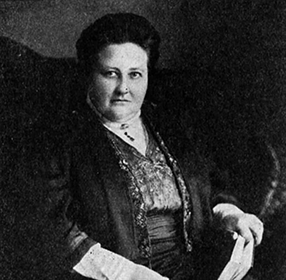From “Evelyn Ray”
I often think of Evelyn Ray.
What did she do, what did she say?
Did she ever chance to pass that way?
I remember it as a lovely spot
Where a cat-bird sang. When he heard the shot.
Did he fly away? I have quite forgot.
When I went there last, he was singing again
Through a little fleeting, misty rain,
And pine-cones lay where they had lain.
This is the tale as I heard it when
I was young from a man who was threescore and ten.
A lady of clay and two stone men.
A pretty problem is here, no doubt,
If you have a fancy to work it out:
What happens to stone when clay is about?
Muse upon it as long as you will,
I think myself it will baffle your skill.
And your answer will be what mine is—nil.
But every sunny Summer’s day
I am teased with the thought of Evelyn Ray,
Poor little image of painted clay.
And Heigh-o! I say.
What if there be a judgment-day?
What if all religions be true,
And Gabriel’s trumpet blow for you
And blow for them—what will you do?
Evelyn Ray, will you rise alone?
Or will your lovers of dull grey stone
Pace beside you through the wan
Twilight of that bitter day
To be judged as stone and judged as clay.
And no one to say the judgment nay?
Better be nothing, Evelyn Ray,
A handful of buttercups that sway
In the wind for a children’s holiday.
For earth to earth is the best we know,
Where the good blind worms push to and fro
Turning us into the seeds which grow,
And lovers and ladies are dead indeed,
Lost in the sap of a flower seed.
Is this, think you, a sorry creed?
Well, be it so, for the world is wide
And opinions jostle on every side.
What has always hidden will always hide.
And every year when the fields are high
With oat grass, and red top, and timothy,
I know that a creed is the shell of a lie.
Peace be with you, Evelyn Ray,
And to your lovers, if so it may,
For earth made stone and earth made clay.
This poem is in the public domain. Published in Poem-a-Day on June 8, 2024, by the Academy of American Poets.
“Evelyn Ray” first appeared in Poetry: A Magazine of Verse in December 1923. The poem was later published in What’s O’Clock (Houghton Mifflin Company, 1925), which won Amy Lowell a Pulitzer Prize in Poetry posthumously. The poem would later be anthologized and is included in Selected Poems of Amy Lowell (Houghton Mifflin Company, 1928), edited by John Livingston Lowes. For the December 1925 issue, Lowell’s colleague and friend, Harriet Monroe, penned a review of What’s O’Clock for Poetry in which she wrote, “It is difficult to take a dispassionate view of a posthumous book—a book published, like this, soon after its author’s death. Yet one can not go far wrong in feeling that this latest, but not quite last, volume adds a special poignancy to the laments for the poet’s passing; because it contains some of her best work, work illustrating not only the fertility and wide range of her mind, but also her increasing control over her chosen instrument. I don’t feel this control in the opening poem, which rambles and gets out of rhythm, like some of its too discursive predecessors in previous volumes. But the second entry, Evelyn Ray [sic], shows not only dramatic intensity but also brevity and concentration, with keen emphasis upon climax. It is, as our readers know, the story of a doubly fatal duel, followed by the poet’s meditations upon the utter blankness of death. She does not pretend to look beyond—no explanation seems adequate […]. Life being inexplicable and death its mere ceasing, Miss Lowell seizes the passing hour of beauty, and gives her readers phases of its color and tune.”

